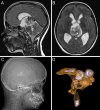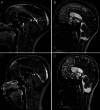Pituitary germinoma after resection of a mature third ventricular teratoma: illustrative case
- PMID: 38976916
- PMCID: PMC11284661
- DOI: 10.3171/CASE2443
Pituitary germinoma after resection of a mature third ventricular teratoma: illustrative case
Abstract
Background: Metachronous intracranial germ cell tumors (iGCTs)-unrelated, histologically different iGCTs occurring at different time points-occurring within the same patient remain a rarity. Herein, the authors report such a case and discuss the literature and potential pathophysiological mechanisms leading to this phenomenon.
Observations: A 9-year-old boy presented with new-onset impaired balance, headaches, nausea, visual disturbances, and left facial paresis. Magnetic resonance imaging (MRI) scans revealed a suspected pineal region teratoma originating from the pineal gland with consecutive obstructive hydrocephalus. A mature teratoma was diagnosed and resected. Postoperative recovery was good, and the patient could return to his normal daily activities. However, a new, slowly progressive lesion in the sellar region with an enlarged infundibular stalk was detected on follow-up MRI 3.5 years after initial pineal region teratoma resection. Biopsy revealed a newly developed pure germinoma. The patient was treated with radiotherapy plus chemotherapy and remained relapse free at the last follow-up. Sixteen other cases have reported a surgically resected primary mature teratoma, wherein patients developed metachronous germinomas during follow-up. Different theories try to elaborate this phenomenon, yet none can completely account for it.
Lessons: Although rare, metachronous iGCT is a phenomenon neurosurgeons should be aware of. In patients treated for iGCT, close long-term clinical, imaging, and laboratory follow-up is recommended. https://thejns.org/doi/10.3171/CASE2443.
Keywords: germ cell tumor; germinoma; mature teratoma; pediatric neurosurgery; pineal gland; pituitary.
Figures



Similar articles
-
Metachronous neurohypophyseal germinoma occurring 8 years after total resection of pineal mature teratoma.Surg Neurol. 1998 Feb;49(2):205-8; discussion 208-9. doi: 10.1016/s0090-3019(97)00158-4. Surg Neurol. 1998. PMID: 9457272 Review.
-
Pure germinoma occurring 11 years after total pineal mature teratoma removal: a case report and review of the literature.Childs Nerv Syst. 2019 Dec;35(12):2423-2426. doi: 10.1007/s00381-019-04332-8. Epub 2019 Aug 5. Childs Nerv Syst. 2019. PMID: 31385089 Review.
-
Bifocal mixed germ-cell tumor with growing teratoma syndrome and metachronous mature metastases: case report.J Neurooncol. 2008 Oct;90(1):111-5. doi: 10.1007/s11060-008-9640-3. Epub 2008 Jun 24. J Neurooncol. 2008. PMID: 18574668
-
Bilateral metachronous germinoma of the basal ganglia occurring long after total removal of a mature pineal teratoma: case report.Neurosurgery. 2002 Mar;50(3):613-6; discussion 616-7. doi: 10.1097/00006123-200203000-00033. Neurosurgery. 2002. PMID: 11841731 Review.
-
Metachronous mature teratoma in the corpus callosum occurring 12 years after a pineal germinoma.J Neurosurg. 2008 Jul;109(1):126-9. doi: 10.3171/JNS/2008/109/7/0126. J Neurosurg. 2008. PMID: 18590442
References
-
- Echevarría ME, Fangusaro J, Goldman S. Pediatric central nervous system germ cell tumors: a review. Oncologist. 2008;13(6):690-699. - PubMed
-
- Jennings MT, Gelman R, Hochberg F. Intracranial germ-cell tumors: natural history and pathogenesis. J Neurosurg. 1985;63(2):155-167. - PubMed
-
- Burnham EL, Tomita T. Histogenesis of intracranial germ cell tumors: primordial germ cell vs. embryonic stem cell. Childs Nerv Syst. 2023;39(2):359-368. - PubMed
-
- Tsuchida T, Tanaka R, Kobayashi K, Ueki K, Koizumi R. Development of 2 cell pattern pinealoma 15 years after total removal of pineal teratoma. No To Shinkei. 1976;28(9):893-899. - PubMed
LinkOut - more resources
Full Text Sources

